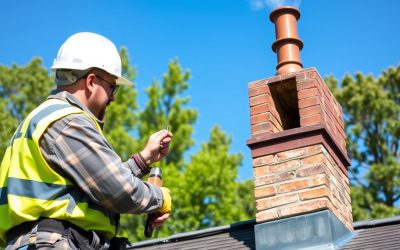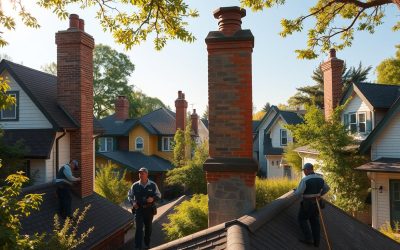A gas fireplace uses a clean-burning gas fuel like propane or natural gas instead of wood. Cleaning wood fireplaces regularly is important because creosote, a byproduct of wood combustion, can be a fire threat if left unchecked.
So, do you need a chimney sweep for a gas fireplace? Absolutely. This is necessary because a clogged gas fireplace chimney can be avoided with regular cleaning and examination. There are various kinds of buildup that might cause harm or decrease efficiency, so they need to have the chimney cleaned.
In this post, we’ll go over chimney Sweep For A Gas Fireplace and why it’s crucial to have a professional clean and examine your chimney often if you have a gas fireplace.
Why Do You Need A Chimney Sweep For A Gas Fireplace?

Raw Gas Leakage
It’s important to inspect for a gas leak when cleaning your gas fireplace. If you detect the odor of raw gas, you must contact the gas company immediately for repair. To prevent any leaks from occurring, the valves will be tested. Your expert should do a thorough inspection of the fireplace and chimney system, looking for any signs of damage or issues that could arise in the future.
Incomplete Combustion
A gas fireplace’s chimney serves two purposes: it passively vents combustion byproducts up the flue, and it actively draws combustion air into the unit via the draft. Insufficient draft from a chilly chimney means insufficient air for combustion. When the draft signal is weak, the chimney can’t properly vent the carbon monoxide that is produced. If you want to stop this from getting worse, have your chimney inspected and cleaned.
Gas Log and Burner Issues
Regular usage of a gas fireplace can cause soot to accumulate on the burners and fake logs. As the gas burners become clogged, the flame quality suffers. Although they were made to last for several decades, the synthetic gas logs can nevertheless deteriorate over time. This requires removing the cap from the pipe that is storing the moisture, cleaning it, and then draining the water.
Condensation
Most gas fireplaces have issues with condensation of water vapor inside the chimney. Conventional fireplaces often produce such high stack temperatures that any moisture escaping from the top of the chimney would simply evaporate. Condensation forms in the flue as a result of the loss of heat caused by today’s gas fireplaces. The problem needs to be addressed as quickly as possible since the water particles that collect inside the chimney are extremely acidic and caustic.
Presence of Deposits
Cleanup is good regularly because of the residue left behind like propane and propylene. Pet hair and dander are also potential vent blockers for a gas fireplace. Since the unit draws air from within the home, it will most likely also draw in dust, dirt, and pet hair. This could lead to obstructions in the burner and the openings in your synthetic logs, resulting in malfunction or poor performance. Regular inspection and cleaning of the unit are essential for maximizing efficiency and minimizing health concerns.
What is Included in a Good Chimney Cleaning Service?

Besides using a brush and vacuum to clean soot and blockages, a professional chimney sweeping service should also evaluate the fireplace and chimney as a whole. Every year, before the cold weather sets in, you should get your chimney inspected to make sure your fireplace is ready for use. You must consider the following for Chimney Sweep For A Gas Fireplace services:
- Blockages in chimneys are the most common reason to hire a sweeping chimney service.
- A comprehensive chimney inspection should also be available from any respectable chimney cleaning service.
- Even if you haven’t used your chimney in a year, you should still clean and examine it annually.
- Schedule a cleaning and inspection of your chimney even if you didn’t use it last year. Even if your chimney is seldom utilized, it still runs the risk of becoming blocked or damaged. Hiring a professional chimney sweep can ensure that your fireplace is clean and ready for use anytime.
How Do You Prepare For a Chimney Sweep?
Follow the following instructions for Chimney Sweep For A Gas Fireplace:
- It’s time to make sure your fireplace has cooled down to the point of safety.
- Remove any furniture or other items from in front of the fireplace.
- Don’t hesitate to voice any concerns you have or to let the chimney sweep know about any peculiarities in the chimney or fireplace.
- Tell the chimney sweep if you’re having problems or if you’ve noticed any changes in the way your chimney works. This will allow them to narrow down their search and get closer to the root of any issues.
People also ask
Do You Know How to Sweep a Gas Fireplace?
The safety and efficiency of your gas fireplace and chimney depend on a comprehensive examination. Professional chimney cleaning and inspection is recommended unless you have extensive experience maintaining gas fireplaces and chimneys.
What Is The Best Time Of Year For Chimney Sweeping?
It’s better to wait until late spring or early summer to have any work done on your chimney. The reason for this is that springtime is the peak nesting season for avian species. It’s not a good idea to schedule a chimney cleaning until after the birds have finished nesting for the year.
How Often Should You Sweep Your Chimney?
Even though gas fireplaces and chimneys leave behind less residue and creosote than wood fireplaces, they still need to be cleaned and inspected once a year. Get in touch with a reliable firm that provides comprehensive chimney and fireplace inspections.
Final Words
Having a gas chimney sweeping service performed is relatively inexpensive compared to the work that could need to be performed if an issue is not found Furthermore, in the end, it will be for the benefit of your health to have it done. If you want to use your gas fireplace without worrying about safety issues, you should get your chimney swept by an expert and qualified technician annually.





0 Comments